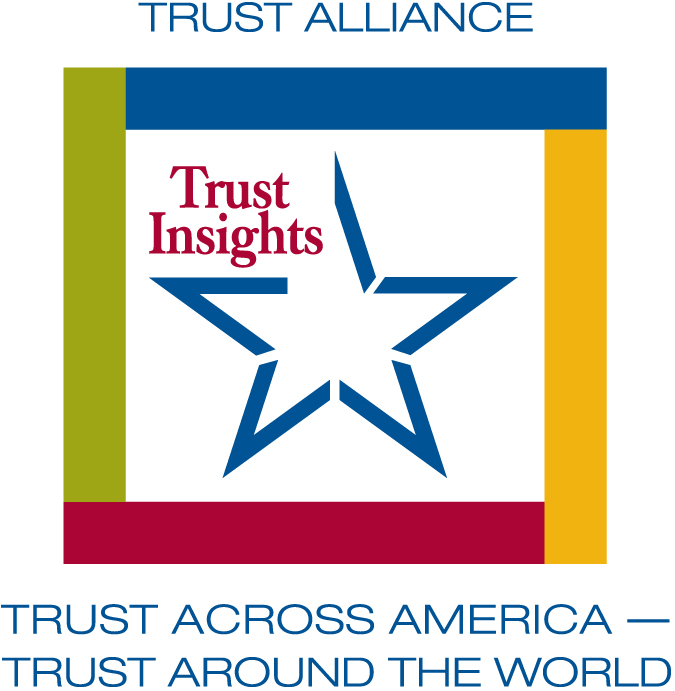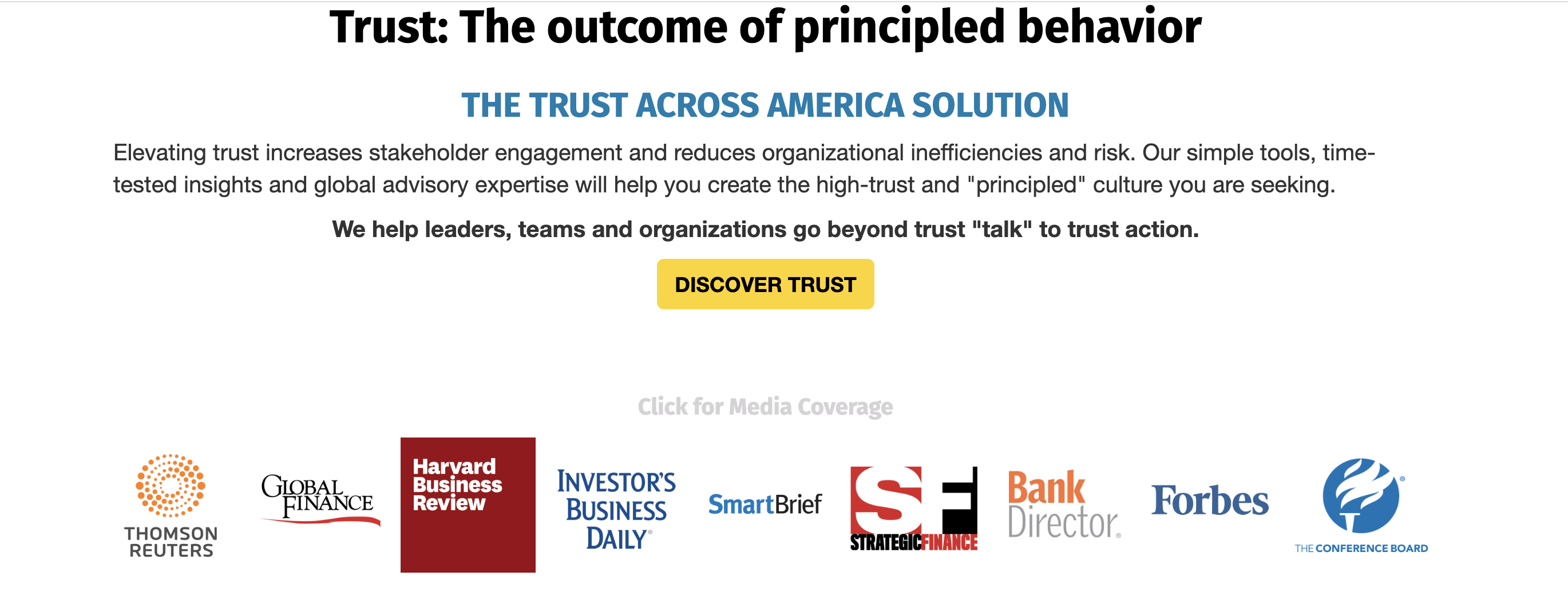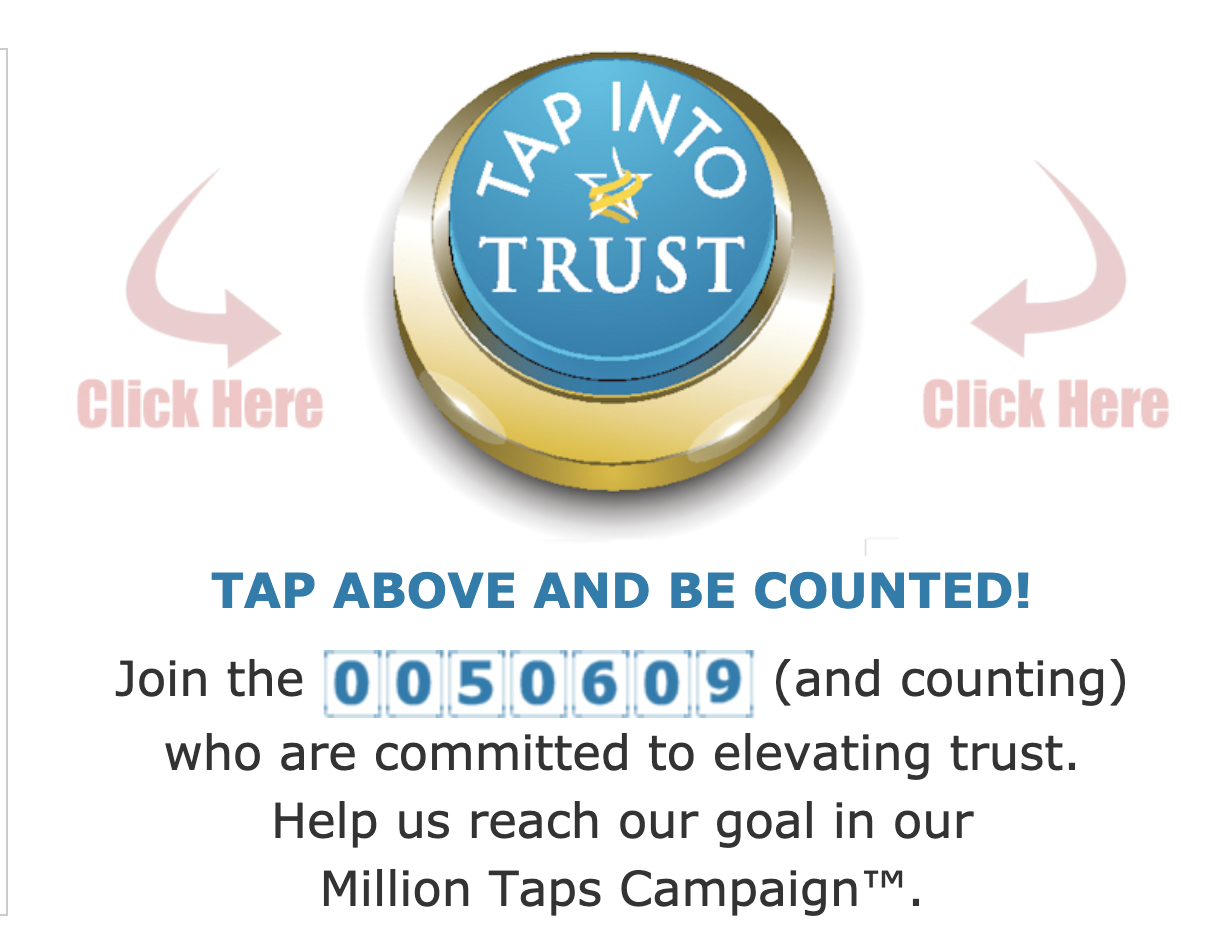Archive
Posts Tagged ‘Aim Towards Trust’

Given the right tools, trust can be measured. Barbara Brooks Kimmel
For decades, the external advisors to senior business leaders have counseled them to measure and evaluate every action according to return on investment. In recent years, box checking has become increasingly popular as well. Have you met your quota for women on boards? Are you decreasing your carbon footprint? Diversity and inclusion? Check. Advisory firms love to build new boxes to keep themselves in business. Last year’s box was “Purpose” and this year it is ESG. Imagine the year that the “trust” box becomes the box of choice. If you need proof that a business case for trust exists, please request it by sending an email to: info@trustacrossamerica.com
The following is a simple starting point to measure whether your employees trust you and trust each other. Ask them to count the behaviors below that are present in your organization.
- High energy, motivation and engagement
- Easy to hire and onboard new employees
- Fun and laughter
- High confidence, creativity and risk taking
- Thriving innovation and productivity
- Team alignment, sharing of information and credit, and quick forgiveness
- Accountability and transparency as the norm
- Willingness to be vulnerable and open, speak freely, and to listen
- Positive team-building behaviors including gratitude, empathy and candor
- A strong sense of “community” and shared values
Now ask them to identify how many of the following are present.
- Low energy, low productivity and burnout
- High employee turnover and excessive use of sick days
- Difficulty recruiting new employees
- Too much focus on risk, rules and regulations
- Low innovation
- No sharing of information and resistance to ideas
- Lack of respect and passive/aggressive behavior
- Resignation and cynicism
- Finger-pointing, water cooler talk and lots of judgment
- Cordial hypocrisy
Subtract the second number from the first to arrive at your trust baseline score.
Let’s say hypothetically your employees identify 5 positive trust behaviors and 5 negative. (5-5=0). Your trust score is zero. Don’t expect much employee engagement, innovation or risk taking.
Or your employees identify 8 positive behaviors from the first list and 2 negative from the second (8-2=6). Six is better than zero.
Or 2 posItive and 8 negative (2-8= -6). Not a place ANYONE wants to work. (And that “trust” box certainly can’t be checked.)
Our AIM Towards Trust survey tool has been used in dozens of teams and organizations to measure trust, start the trust discussion and fix what’s broken. The proactive and ethical business leaders who have adopted these tools can now check that trust box with confidence.
Before you leave, Tap Into Trust and complete our 1 minute/1 question quiz. Find out how the level of trust in your workplace compares to 500 others.
Have you reviewed how our workshops are helping teams and organizations just like yours elevate trust? Schedule an ONLINE webinar today.
Did you miss our previous 2020 Trust Insights? Access them at this link.
Contact us for more information on elevating trust on your team or in your organization or email me directly:
Copyright 2020, Next Decade, Inc.
Aim Towards Trust, Barbara Brooks Kimmel, C-Suite, culture, leadership, organizational trust, Trust Inc. Strategies for Building Your Company's Most Valuable Asset
 The benefits of high trust are too numerous for leaders to continue to ignore.
The benefits of high trust are too numerous for leaders to continue to ignore.
Barbara Brooks Kimmel, Founder Trust Across America-Trust Around the World
Study after study confirms that over the long-term, high trust organizations outperform their low trust competitors. These are a few of the benefits:
- Elevated employee engagement and retention
- Reduced workplace stress
- Enhanced decision-making
- Innovative culture
- More accountability, transparency and communication
- Reduced costs
Why do most leaders choose to ignore trust or take it for granted?
The greatest challenges to elevating trust are the inability to delegate it, and having the right tools to fix it. Trust is a top down imperative that cannot be addressed via regulation and requires its own budget. It is not a Corporate Social Responsibility or “purpose” project, nor a compliance, human resources or marketing function, but rather an intentional business strategy adopted by leadership and practiced and reinforced daily. According to the Business Roundtable, vanishing are the days of low transparency, “short-term” thinking and maximization of shareholder value at the expense of other stakeholders. And as low trust continues to make the headlines across the globe, organizations that choose trust as an intentional strategy will continue to outperform their peers.
Take a look at some of the more recent study results:
- On average, Trust Across America’s (that’s us) annual “Top 10″ most trustworthy public companies have outperformed the S&P 500 by over 25% since 2012 (June, 2018). This study has also been referenced by Gartner and in the Harvard Business Review.
- Salesforce Research (2018) surveyed over 6,700 consumers and business buyers globally to better understand the modern customer mindset. 95% of customers say that if they trust a company, they’re more likely to be loyal patrons.
- PwC’s Global Consumer Insights Survey (2018) asked consumers which factors, other than price, influence their decision to shop at a particular retailer. More than one in three (35%) ranked ‘trust in brand’ as among their top three reasons.
- Another study looking at workplace trust and the impact on employee wellbeing reveals that more than half (53%) of employees considered it to be a major factor in whether they stayed or left a company. More research on the link between trust and wellness in this recent SmartBrief article.
- According to Gallup, when employees don’t trust organizational leadership, their chances of being engaged are one in 12. But when that trust is established, the chances of engagement skyrocket to better than one in two. That’s more than a six-fold increase.
These references are bolstered by dozens of others. Short-sighted business leaders may continue to challenge the “return on trust” but the evidence is mounting. There is not only a business case but also a financial case for trust.
How can leaders elevate trust proactively instead of addressing it after a crisis and playing catch up?
It requires moving beyond talk to acknowledgement followed by ownership and action. Late last year Trust Across America-Trust Around the World introduced a quick and simple survey tool called AIM Towards Trust and Workshop opportunities for teams and organizations of all sizes and in any industry to begin a trust discussion and address the challenges that are holding back trust. The survey has been successfully administered in dozens of teams, organizations and in advance of conferences and workshops. Readers interested in reviewing its various applications can learn more at this link.
Making the decision to elevate trust is not easy. It requires both introspection on the part of leadership and a certain amount of vulnerability. Virtues like trust, the ones that really matter, must be treated as business imperatives for those who are seeking long-term success. Waiting for the inevitable crisis (most are the result of low trust) to make the old and tired PR speech, declaring that trust must be rebuilt may be the most popular choice, but as we have seen, it’s also the most expensive and least effective. Just ask Wells Fargo.
Barbara Brooks Kimmel is the Founder of Trust Across America-Trust Around the World. Now in its eleventh year, the mission is to help organizations build trust. That’s all we do.
Copyright 2020, Next Decade, Inc.

Aim Towards Trust, Barbara Brooks Kimmel, CEO, FACTS(R), leadership

It’s Sunday. What are your plans for tomorrow?
Did you know that twice as many people call in sick on Mondays as compared to Fridays?
That’s 24.8% vs.12.8% according to a recent study conducted in the UK. And few would argue that employee absenteeism places pressure on productivity, morale AND the bottom line, but who’s keeping track?
Putting reasons aside like sickness or a hurricane, the following common workplace occurrences are fueling Monday absenteeism:
- Truth takes second place to personal and professional gain
- Accountability is expected but not practiced by management
- Short-term wins beat long-term purpose
- Talk and actions don’t match
- Only one voice matters and it’s not yours
- Moral character? What’s that?
- Closed doors and closed mindedness abound
- Hidden agendas stifle transparency
- Fear is rampant and rules “rule”
- Failures are punished
- Honesty is not encouraged
- Shared values are non-existent
Can you name the common thread running through these?
If you guessed low trust you are correct, and it is present in almost every workplace. Low trust, leads to low morale which, in turn, increases employee absenteeism.
The fixes aren’t all that difficult if you can get past Step #1 below.
Step #1 ACKNOWLEDGE that trust is low. That’s the hardest part. Reviewing these universal principles and answering this one question/one minute anonymous survey will help. (Almost 70,000 people already have)
Step #2 Identify which principles are weak in your organization. They won’t all be and strengths can be celebrated.
Step #3 Mend them with these tools. You can do it yourself or contact barbara@trustacrossamerica.com
Why have YOU chosen to call in sick tomorrow? What actions can you take to curb “Mondayitis?”
Barbara Brooks Kimmel is the CEO at Trust Across America-Trust Around the World whose mission is to help organizations build trust.
Copyright 2019, Next Decade, Inc.
Aim Towards Trust, Barbara Brooks Kimmel, employee engagement, leadership, organizational trust, values

What gets measured gets managed – Peter Drucker
In preparation for the first anniversary of Tap Into Trust, we have been running an anonymous one question/one minute survey to identify the primary causes of low trust in organizations. The results may surprise you and provide insight into what needs fixing.
Which of these 12 trust principles do you consider the weakest in your organization?
Transparency? Integrity? Respect? None of those would be correct.
- Truth
- Accountability
- Purpose
- Integrity
- Notice
- Talent
- Openness
- Transparency
- Respect
- Understanding
- Safety
- Tracking
Take the survey and find out.
Remember, You can’t manage what you haven’t measured.
Trust is always internal and must be built from the inside out. Everything else is simply “perception of trust.”
Learn how you can bring this trust diagnostic into your team or organization.

For more information contact:
Barbara Brooks Kimmel, CEO and Cofounder Trust Across America-Trust Around the World barbara@trustacrossamerica.com
Copyright 2019, Next Decade, Inc.
Aim Towards Trust, Barbara Brooks Kimmel, organizational trust, Tap Into Trust, trust, trustworthy behavior






Recent Comments